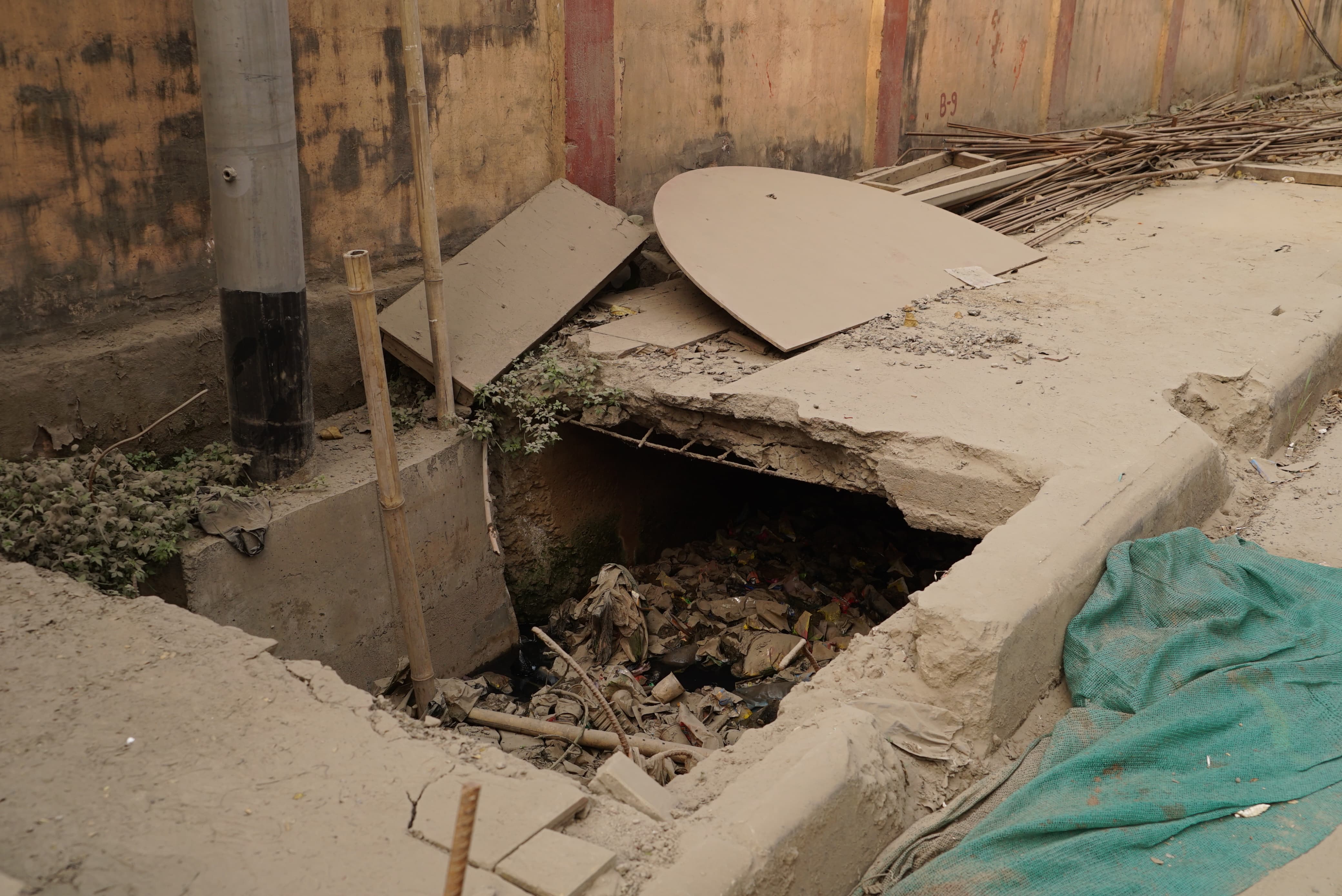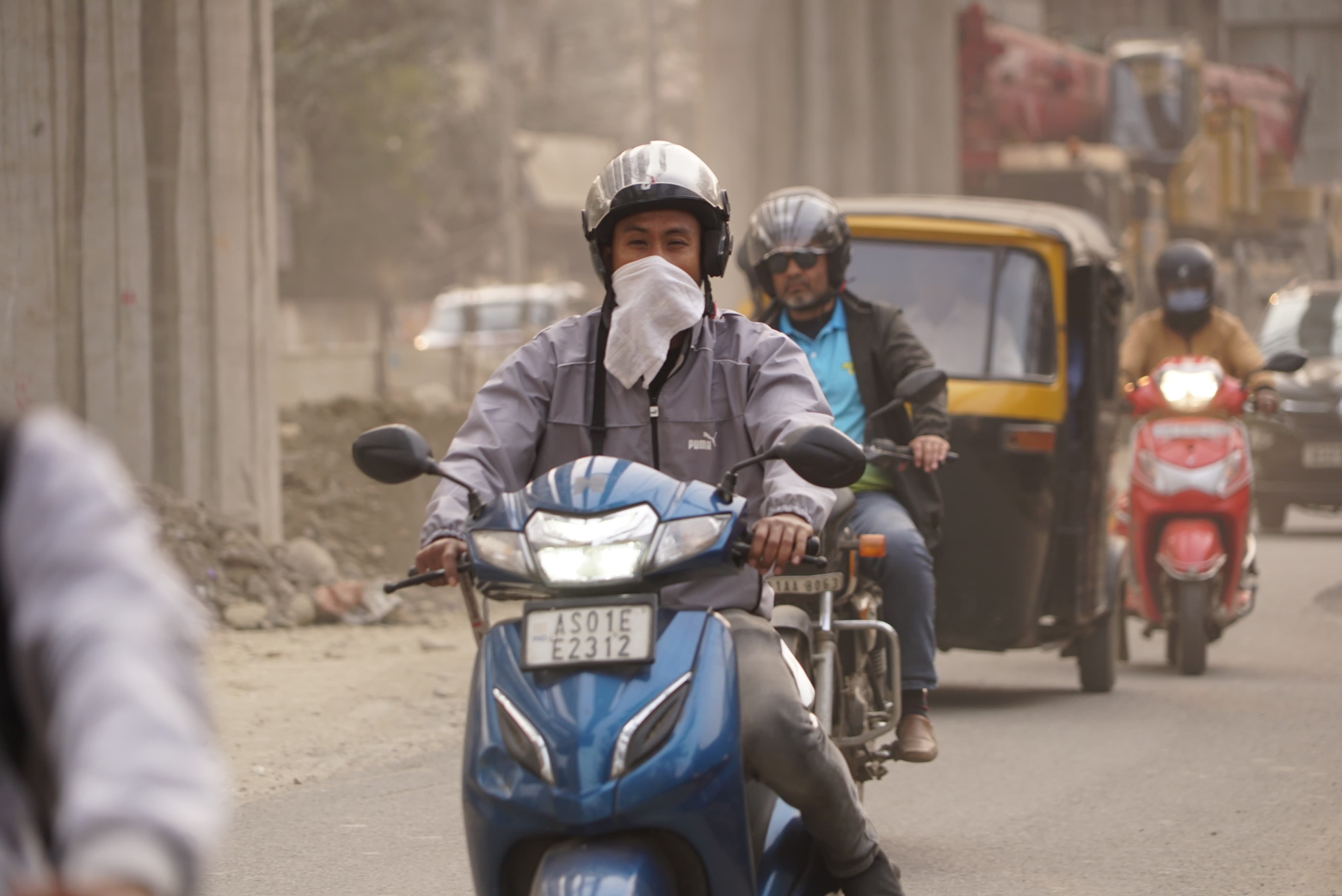Focus Area: Bamunimaidam
Ward No: 54
Population: 11,000 (approx)
Voters: 10,480
Ward Councillor: Geeta Thakuria
Bamunimaidam has now turned into a zone of chaos and distress. The flyover construction, combined with poor planning, waterlogging, and official neglect, has made daily life miserable for Bamunimaidam residents. Dust fills the air, roads are barely motorable, and pedestrians are left with no choice but to wade through stagnant, dirty water.
ALSO READ: Guwahati Gets A Facelift Ahead Of PM Visit, Advantage Assam 2.0
For over a month, locals have raised concerns about the deteriorating conditions, but their pleas seem to have fallen on deaf ears. The drainage system, once a crucial component of the neighbourhood’s infrastructure, is now clogged with construction debris. The roads, filled with potholes and mud, have become a nightmare for commuters.
The combination of incomplete projects, alleged poor planning and official neglect has turned Bamunimaidam into a scene of urban decay.

An open and clogged drain.
Construction Nightmare: More Harm Than Progress?
The flyover project, which is supposed to connect Dighalipukhuri to Bamunimaidam, was initially welcomed as a development initiative that would ease traffic congestion.
However, its execution has been riddled with problems. Large heaps of construction materials, including concrete slabs, broken timber, and piles of earth, have been left scattered across roads and footpaths. The drainage lines, already under strain, are now completely blocked by debris, resulting in knee-deep water accumulating in various parts of the locality.
A senior resident of Barnachal Path, speaking to GPlus said, “This place has turned horrendous. From traffic congestion to dust pollution, it has become extremely difficult to commute. The footpaths were constructed just four to five months ago, but due to poor planning, they had to be relaid. First, they were built too low, causing waterlogging. Now, the slabs are lying open, which can easily lead to accidents.”
“As an elderly person, I need warm water in the morning, but every day, the electricity goes off from 3:30 a.m. to 8:30 a.m. It’s a struggle for us, especially for my grandchildren, who have to get ready for school and college,” said a senior resident.
Frequent power cuts in Bamunimaidam have added to the daily hardships of residents, making mornings stressful for families. Despite repeated complaints, there has been no resolution to the problem.
Another resident pointed out a particularly serious problem in Bylane 2 of Barnachal Path.
“The culverts were built too low compared to the road, and now they serve no purpose. There are potholes everywhere, and it’s just a matter of time before a serious accident happens.”
The lack of clear communication regarding road restrictions has added to the chaos. No-entry signage’s appear at random times, leaving commuters confused. Without proper planning, even pedestrians find it difficult to navigate through the area.
Rakesh Dutta, a private sector employee who commutes daily through Bamunimaidam said, “Every other day, I find a no-entry sign placed randomly. There’s no prior notice, no alternative route mentioned. I end up wasting 20–30 minutes just figuring out how to reach my destination. It’s a complete mess.”
For pedestrians, the situation is no better. College student Priyanka Das said, “The footpaths are either blocked by construction materials or simply unusable. We have to walk on the road, dodging traffic. It's risky, and no one seems to care about pedestrian safety.”

Guarding against dust.
Health Crisis Looming Over Bamunimaidam
The dust pollution has not only made the streets unwalkable but has also given rise to severe health hazards.
“We are breathing dust every day. My children keep coughing, and my elderly parents are having trouble breathing. Doctors say it’s because of the dust, but what can we do? We cannot stop stepping out,” said Dipankar Sharma, a resident in the area.
Another local in Maniram Dewan road talking to GPlus said, “I wake up sneezing, my throat burns, and my eyes itch all the time. The moment we step outside, a cloud of dust covers us. We need immediate action before more people fall sick.”
However, with construction chaos taking over, foot traffic has dwindled drastically. Shopkeepers are seeing losses pile up as customers prefer to avoid the area altogether.
Sujit Deka, who runs a small grocery shop in the neighborhood talking to GPlus said, “My sales have dropped by more than 50% in the past two months. People don’t want to come here anymore. The roads are filthy, there’s no space to walk, and the whole area stinks. If this continues, we will be forced to shut down.”
For small business owners, the losses are devastating. With no financial aid or relief from the authorities, they are left wondering how long they can sustain themselves. The construction project, meant to improve the locality, has instead disrupted livelihoods, making survival increasingly difficult.
“Who puts streetlight poles in the middle of a drain?” asked Ranjan Bora, a daily commuter. “It’s as if they want to make things worse. If this continues, someone is going to get electrocuted.”
With roads submerged, drains overflowing, and basic infrastructure in disarray, Bamunimaidam residents are growing increasingly restless.
In a bid to draw attention to their plight, residents have taken to social media to voice their frustrations. On January 27, senior Congress leader Bobbeeta Sharma posted on X (formerly Twitter):
“When a flyover is under construction, there is no space for vehicles to ply, forget about pedestrians! Now look at these pictures! How do you expect pedestrians to walk when even footpaths are blocked by incompetent authorities? Who is responsible for this mess? @GMDAGuwahati @apdclsocial @CMOfficeAssam”
The post quickly gained traction, with several users commenting about similar issues in their respective localities. The online outrage highlights the broader failure of urban planning and governance in Guwahati.
The people of Bamunimaidam are demanding immediate action to address the problems plaguing their neighbourhood. Immediate steps such as clearing construction debris, ensuring proper drainage, and improving pedestrian access need to be taken before the situation spirals further out of control.
Speaking to GPlus, Ward Councillor Geeta Thakuria offered little reassurance. “The construction work is ongoing, so people might face difficulties for now. But once the project is completed, everything will be fine. The desiltation work is in progress, which is why some drainage slabs are still open."
Such statements do little to instill confidence in the residents, who have already endured months of hardships with no end in sight.
The crisis in Bamunimaidam raises serious questions about the city’s priorities. While large-scale infrastructure projects are necessary, their execution must not come at the cost of public well-being. Development should not mean forcing residents to suffer through mismanaged construction work, health hazards, and financial losses.
The people of Bamunimaidam are not asking for luxury—they are demanding basic civic amenities, something every citizen is entitled to.



